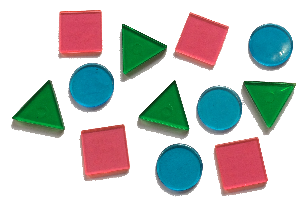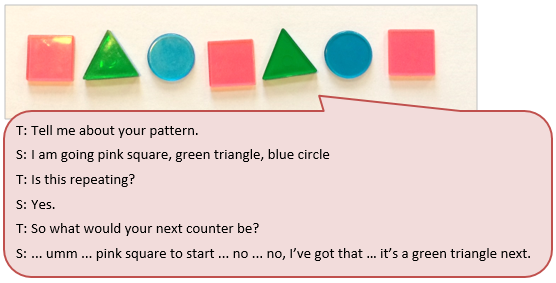The purpose of this activity is to engage students in identifying the similarities and differences of solid objects and using these attributes to produce a repeating pattern.
This activity assumes the students have experience in the following areas:
- Recognising similarity in objects and shapes.
- Using materials to model situations.
- Copying, and continuing, sequential patterns.
- Creating repeating patterns.
The problem is sufficiently open ended to allow the students freedom of choice in their approach. It may be scaffolded with guidance that leads to a solution, and/or the students might be given the opportunity to solve the problem independently.
The example responses at the end of the resource give an indication of the kind of response to expect from students who approach the problem in particular ways.

Arrange these counters in a repeating pattern.
Describe your pattern and say what would come next if you had more counters.
Note to teacher: Students should be provided with 12 counters, buttons or other small objects. The 12 items should be four lots of three different shapes and colours.
The following prompts illustrate how this activity can be structured around the phases of the Mathematics Investigation Cycle.
Make sense
Introduce the problem. Allow students time to read it and discuss in pairs or small groups.
- Do I understand what I need to do? (Create a sequential pattern.)
- Do I understand the words? (“Repeating pattern” and “next’ may need explanation and illustration.)
- How will I know when I have a repeating pattern?
Plan approach
Discuss ideas about how to solve the problem. Emphasise that, in the planning phase, you want students to say how they would solve the problem, not to actually solve it.
- What strategies will be useful to solve a problem like this? (Trial and error may work but establishing the unit of repeat first is an important strategy.)
- How will I organise the objects, so it is easy to see my pattern?
- How will I record my pattern? (Digital photographs are a useful recording tool.)
Take action
Allow students time to work through their strategy and find a solution to the problem.
- Is my strategy working or do I need to be more orderly?
- Have a tried some patterns? Do they work? If not, how can I change them so they repeat?
- Is the working clear so someone else can follow it?
- How can I express how my pattern repeats, using diagrams, numbers, and words?
Convince yourself and others
Allow students time to check their answers and then either have them pair share with other groups or ask for volunteers to share their solution with the class.
- Is my working clear for someone else to follow?
- How would I convince someone else that my pattern repeats?
- Is my solution expressed in a sequence?
- Can I create a more complicated repeating pattern? How will I do that?
- Can I come up with a general strategy that works for creating repeating patterns?
Examples of work
Work sample 1
The student arranges the set of objects into a simple repeating pattern.
Click on the image to enlarge it. Click again to close.
Work sample 2
The student creates their own sequential pattern with the objects and is able to explain how the pattern was created.

